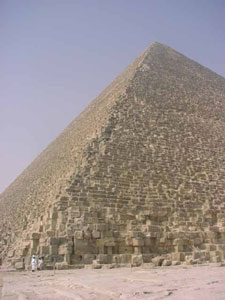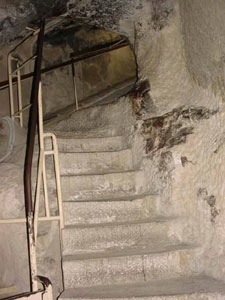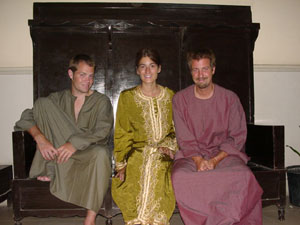![]()
| Egypt | Cairo | 2001.05.21 - 05.23 |
Pyramids
Other travelers said Cairo has been cleaned up over the past 5 years. Today it resembles Manila (Philippines) with traffic congestion, horns blaring 24 hours a day, and a visible brownish-gray haze enveloping a 50km wide area. So how bad was Cairo 5 years ago?
Disliking large polluted cities, we stayed just long enough to see the Sphinx and Pyramids in nearby Giza and the Egyptian Museum in downtown Cairo.
GETTING THERE
Buses and trains radiate from Cairo to every location in Egypt.
Coming from Luxor, the cheapest and most comfortable way to Cairo is by
first class train. Trains from Luxor depart two or three times per day:
once in the morning and once or twice in the evening. We boarded the
23:00 departure and reached Cairo at 08:30 the next morning. The first
class section of the train was nearly empty. There were a total of 6
passengers - all backpacking foreigners - in the entire car. We each had
a full row of comfortable seats in private compartments to ourselves.
The sleeping was better than at many of the hotels we stayed since beginning travel
in the Middle East. Just before entering the Cairo train station, our
train stopped on the tracks next to a 2-story high football field-sized
garbage heap. "Welcome to Cairo" we joked.
Egyptian Museum
A quarter of the Egyptian Museum is devoted to treasures from the Tomb of Tutankhamun. These displays alone make a visit truly worthwhile. While walking mesmerized from Tutankhamun's artifact to elaborate artifact, remembering that Tutankhamun was a minor king puts into perspective the quantity and quality of items stolen by grave robbers from other tombs in the Valley of the Kings. Admission is E£ 20 (E£ 10 with student card) plus E£ 10 to carry in a camera and E£ 100 to carry in a video camera.
Pyramids of Giza
"I came to Egypt to see the Pyramids," is a common comment by travelers in the region. Impressive they are. Built 4500 years ago and standing today, the Pyramids are the only remaining ancient "7 wonders of the world". On the approach, their tips rise above the surrounding landscape like mountains. It could only be better without the persistent brown-gray haze of Cairo.
The cheapest luxury transport option to the Pyramids is Bus 355 from the Egyptian Museum. The 15km trip takes about 30 minutes and costs E£ 2. Buses are the cleanest in Egypt, air conditioned, and run every half hour. The last stop is 5 minutes walk downhill from the Pyramids.
A walk around the Pyramids costs E£ 20 (E£ 10 with student card). At all times, 2 of the 3 Pyramids are open to the public on a rotating basis. Admission into a large Pyramid is E£ 40 (E£ 20 with student card) plus E£ 10 to carry in a camera and E£ 100 to carry in a video camera. Admission into the small Pyramid is E£ 10 (E£ 5 with student card).
Everywhere, inside or outside the Pyramid site, are camel-ride and horse-ride sales. The posted fee is E£ 15 per hour. However, if riding a taxi from Cairo to the Pyramids (cost is typically E£ 15 one-way), the driver will invariably take the tourist to a village where camel rides are sold for E£ 60.
 |
The Sphinx sits in front of the Pyramid of Chephren. This photo was taken during the least hazy part of the day, yet the 300 meter far Pyramid appears to be distant. |
 |
Looking up the corner of the Pyramid of Cheops, the largest Pyramid of the three main ones. |
 |
Within the Pyramid of Cheops, stairs lead up to vacant square rooms that once held mummies and treasures. The inside is hot, humid, and uninteresting, but if you came all the way to Egypt to see the Pyramids, peak inside. |
 |
Our travel partners pose in their newly purchased galabeyyas. Left to right is Ryan from Vancouver and Stephanie and Eric from Montreal. |
Copyright © 2000-2002 Wes and Masami Heiser. All rights reserved.